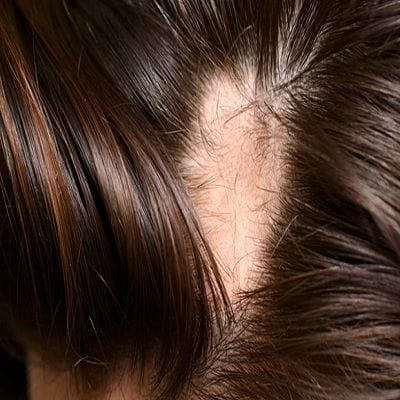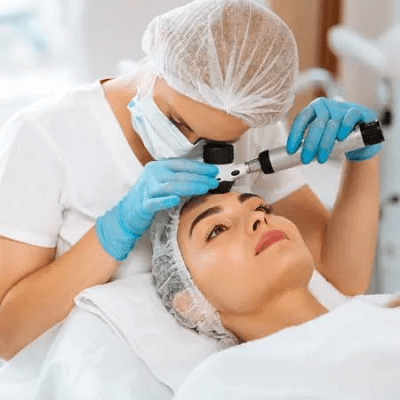
When people meet us, one of the first elements they notice about us is our hair. Hair reflects your particular style and attitude. Women’s hair care may become more vital throughout their lives, especially as they become older. Hair loss affects certain women as they become older, especially during menopause. It affects many men as well due to high levels of testosterone or genetics as they get older. Female or male pattern baldness in Dubai over the age of 50 is a typical occurrence. Hair loss in women may be unpleasant and have a terrible impact on self-esteem. Still, there are a variety of tactics and treatments executed by the best dermatologist in Dubai available to help.
Alopecia is the medical name for baldness. Alopecia areata in Dubai is baldness that leads to patches on the scalp. Continue reading to discover more about the reasons for female hair loss and treatment options offered by dermatologists in Dubai.
What is Alopecia?
Alopecia areata is a disorder in which hair falls out in tiny spots that might be difficult to see. However, these patches may link and become visible. The disease develops when the immune cells target the hair follicles, causing hair loss.
Hair loss may occur anywhere on the body, including the scalp, brows, eyelashes, and face, as well as other regions of the body. It might also take a long time to develop and reoccur after a long period of time.
The illness, known as alopecia universalis, may cause complete hair loss and prevent new hair growth. It’s conceivable that hair may fall out again once it grows back. Hair loss and regeneration vary in intensity from individual to person.
Alopecia areata has no known treatment at this time. There are, however, treatments that may help hair regrow faster and stop potential hair loss, as well as creative strategies to conceal hair loss. Additional resources are available to assist individuals in dealing with hair loss stress.
What Causes Alopecia?
Alopecia areata is an autoimmune disease, which is a disease that occurs when the immunity system identifies the healthy cells as foreign substances. Usually, the immune system protects people from these foreign cells like viruses and bacteria.
However, if you have alopecia areata, the immunity system mistakenly attacks your hair follicles. The regions from which hairs develop are known as hair follicles. Hair loss occurs when the follicles shrink and cease generating hair.
The specific aetiology of this illness is unknown to researchers.
However, it is more common in people with a hereditary condition regarding autoimmune diseases like diabetes or arthritis. Some researchers believe genetics may have a role in the onset of alopecia areata.
It is also thought that environmental factors and weather conditions are linked to causing alopecia areata in people who are genetically prone to the condition.
Symptoms of Alopecia
Early-onset of hair shedding from the head is the most common sign of alopecia areata. Hair comes out in little patches on the scalp most of the time. These patches tend to be a few millimetres or less in size.
Other regions of the face, such as the eyelashes and beard, as well as many other areas of the body, may experience hair loss. Some individuals have hair loss in a few areas. Others have a tendency to lose it in a variety of places.
Hair clumps on the bed or even in the shower may be the first sign. Somebody might bring it to your notice if the patches are on the nape of the neck or the back of the head. On the other hand, other health issues might induce hair to fall out in the same way. Alopecia areata isn’t diagnosed just on the basis of hair loss.
Some persons may notice more significant hair loss in rare circumstances. This is often a sign of a different kind of baldness, such as:
- Alopecia totalis is a condition in which all of the hair on the scalp is completely lost to shedding.
- Alopecia universalis is a condition in which every hair on the body is lost.
Doctors should avoid using “totalis” and “universalis” since some persons may have similar symptoms. Hair could also be lost completely on the arms, legs, and temples, but not on the torso, for example.
According to physicians and experts, hair loss linked with alopecia areata is unexpected and seems to be spontaneous. Hair could grow back and then fall out again at any moment. The amount of hair loss and regeneration varies significantly from one individual to the next.
Treatment Options
The following are a few treatment options that can help slow down or reverse the process of baldness.
Laser Therapy
Low-level laser therapy is a hair-regrowth and hair-reversal treatment for women. The lasers may be used at home or at doctors’ offices. Before seeing benefits, patients must administer laser treatment for two to four months. Alternatives to medicine and hair transplant surgery include laser treatment. Low-level laser treatment does not have long-term safety and effectiveness evidence. For men and women who have suffered from certain types of hair loss, laser treatment may be useful.
Immunotherapy that is applied to the skin
Topical immunotherapy is a method of causing an allergic response by applying drugs directly to the scalp. As a result, the immune system is stimulated, and hair development is aided.
Under the supervision of a dermatologist, this course of therapy is generally recommended and guided.
It has the potential to be extremely successful. After roughly 6 months of treatment, patients receiving topical therapy will regenerate scalp hair.
If the therapy is effective, ongoing usage should result in hair growth.
Minoxidil
Minoxidil is a topical therapy that is simple to use and may be bought over the counter. Once the follicles are no longer under assault by the immune response cells and capable of creating hair, minoxidil helps it grow quicker.
Topical minoxidil solutions are typically available in different concentrations. Once or twice a day, apply the therapy straight to the scalp or any other place where it is needed.
It promotes hair development by increasing blood supply to hair follicles, activating dormant follicles, and stimulating dormant follicles.
When used at the prescribed dosages, this therapy has few adverse effects.
It’s reasonably priced and may be purchased as a subscription if desired.
Anthralin Topical Cream
Anthralin cream was developed to treat psoriasis, but it was shown to be effective for the treatment of moderate alopecia areata as well.
Anthralin causes an irritating response in the body, boosting the immune system and promoting hair growth.
Anthralin is applied to the scalp once a day in places where you wish to increase hair growth. It’s left on for a predetermined amount of time before being washed off.
Hair regeneration is relatively rapid if the procedure is effective. Anthralin may promote new hair growth in as little as 2 to 3 months. It’s simple to do at home.
A dermatologist is generally the one who prescribes and monitors anthralin.
Injectable Corticosteroid
Corticosteroid shots are often used to treat alopecia areata because they reduce inflammation and modify immune system activity.
When the immune system attacks the body’s normal functions, people with alopecia areata lose their hair. Corticosteroids help to avoid these types of attacks.
Corticosteroids are hormones that imitate cortisol, a hormone generated naturally by the adrenal glands. They’re injected into balding areas to promote fresh hair growth.
Hair may grow in as little as four weeks.
It is given by a dermatologist every 4 to 6 weeks.
Injections of corticosteroids are still a common first-line therapy for alopecia areata.
Bottom Line
Alopecia areata is a difficult condition to live with, particularly when it involves the whole scalp. People who have the syndrome may experience loneliness or unhappiness. At Dynamic Clinic, we provide patients with the best dermatologist In Dubai to help address the issues as well as treatment options for pattern baldness. So, schedule an appointment with our health representatives for a free consultation.











